House-wide heating meters: procedure and options for calculating heating
Residents of apartment buildings are often interested in how profitable are common house heating meters, the installation of which has recently been mandatory in all regions of Russia.
This question is difficult to answer unambiguously, since there are several options for calculating the monthly fee for such a service. Let us consider in more detail the existing accrual procedures, taking into account all sorts of nuances.
The content of the article:
- The need for installation of common house flow meters
- Varieties of common house heat meters
- Before installing the flowmeter, you need to know
- Settlement operations for a common house appliance
- Benefits of Using Counters
- Calculation of heating standards
- Approval and Tariff Approval Process
- Conclusions and useful video on the topic
The need for installation of common house flow meters
The Federal Law of the Russian Federation dated 11.23.09 No. 261-ФЗ “On energy saving of energy resources and the use of metering devices for used energy resources when calculating for them” indicates the importance of installing common house meters designed to control heat consumption.

The regulation requires the installation of such devices in all apartment buildings, with the exception of emergency buildings. In addition, it was considered impractical to equip buildings with these devices if the amount of payment for the purchase and installation of the flow meter exceeds the amount of heating payments received within six months.
Legislators believe that this Regulation will contribute to the achievement of the following objectives:
- Fair distribution of payment for heat supplied to homes.Homeowners who care about reducing heat loss (for example, those who insulate an apartment or facade) should pay less than those who constantly leak heat through slots or open windows.
- Motivation of residents to respect both residential and communal premises. They should know that the heating fee will automatically increase in the case of an open door or broken windows, not only in the apartment, but also in the entrance.
In addition, Law No. 261 officially transfers to residents the responsibility for communal property. According to this legal act, utilities are no longer responsible for the condition of entrances, basements and attics. All work in public places should be carried out at the expense of the owners of apartments located in the same house.
Varieties of common house heat meters
As heat control devices, various equipment is used, which can vary in the way of work, design features, specifics of maintenance and installation.
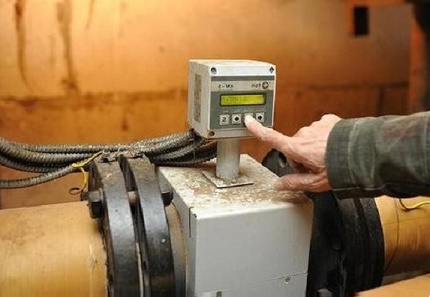
Specialists of an organization engaged in the installation and maintenance of such devices in a city (region) will help to decide on the installation of a particular model. They will talk about the features of the devices, recommend options that work best in local conditions.
They will also advise on equipment (valves, filters, etc.), which should be purchased additionally, and will also give advice on the warranty obligations of the supplier.
Most often, four types of flow meters are used in housing and communal services:
- tachometric (mechanical);
- vortex;
- electromagnetic;
- ultrasound.
Consider the above devices in detail.
Option # 1: Tachometric
Such devices, the system of which includes mechanical rotary or vane devices and heat meters, are considered the most budgetary option, since their cost is much lower than similar devices of other types.
However, in addition to standard equipment, their installation requires an additional magnetic-mechanical filter that protects the device itself and the entire system from pollution.
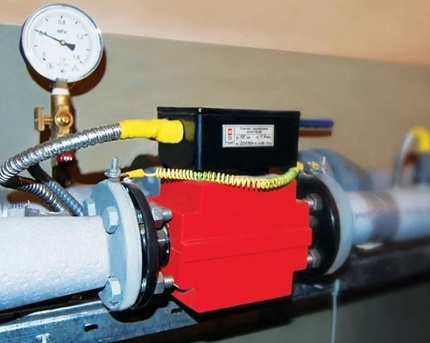
The main disadvantage of this category of models is the inability to use them with low quality coolant (increased rigidity, a large percentage of impurities). In this case, the filter quickly clogs, causing a decrease in the pressure of the coolant. Due to this feature, tachometer counters are usually used only in the private sector.
Option # 2: electromagnetic
The basis of such devices is the well-known property of liquids - the generation of electric current during the passage of magnetic fields. By measuring the volume of water and the incoming / outgoing temperatures, even very small currents can be detected.
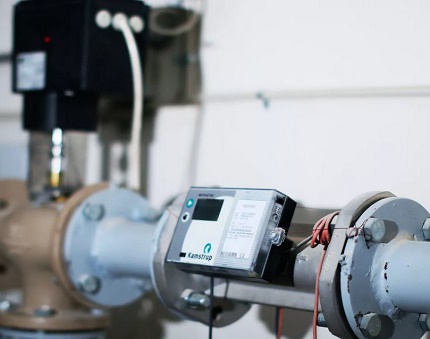
Electromagnetic devices are characterized by a high degree of accuracy, but require high-quality installation and regular maintenance by qualified personnel.
With untimely cleaning of the device, they begin to overestimate the readings. The high content of glandular compounds in the liquid and poor-quality wiring also contribute to the big data distortion.
Option # 3: Vortex
When a fluid stream meets an obstacle in the water, turbulences form. The action of mechanisms of this type is based on this principle. Such measuring devices can be installed both on horizontal and vertical sections of communication systems, the main thing is that the device is located on a straight section of the pipeline.
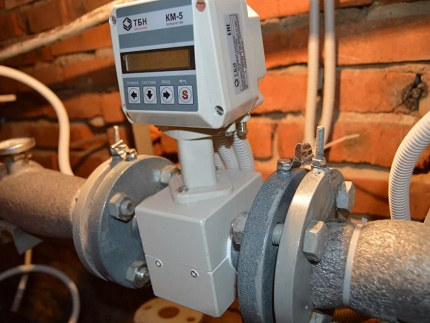
The advantages of such meters include low energy consumption (one lithium-ion battery lasts about 5 years). Vortex meters are sensitive to pressure drops, as well as the presence of large impurities, which is why they require additional installation of filters.
At the same time, impurities of metal salts in water, as well as deposits formed in pipes, do not affect the readings of devices.
Option # 4: Ultrasound
Indications of this type of apparatus are based on the passage of an ultrasonic signal through a water stream. The higher the speed of the latter, the longer the wait for a response.

Devices of this type show themselves well in new homes, in the pipes of which there is no deposits. However, impurities, differences pressure in the heating system, air bubbles in water can significantly increase the readings of flow meters in this category.
Before installing the flowmeter, you need to know
All expenses for the acquisition, installation, maintenance of the device are borne by the residents. Owners of non-privatized apartments will be reimbursed by the local municipality for installation costs.
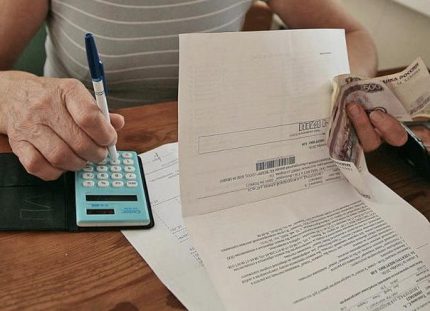
The choice of the organization that will take over the installation of the device requires special attention. It is advisable that the same company is also involved in meter maintenance, including timely cleaning of filters, conducting routine repairs, and regular inspection of the instrument.
External negative factors
It is also important to consider that many external factors influence the correct operation of flowmeters.
Among them can be called such reasons as:
- The formation of mineral deposits in the pipes, because of which their inner diameter decreases. This causes an increase in flow. Since measuring instruments are designed for a certain size of elements, a decrease in this indicator will lead to incorrect calculations, and the result will exceed the actual value.
- The presence of impurities in the water. Mechanical impurities and air bubbles cause a significant error of readings, reaching 10%. To clean the liquid, it is recommended to additionally equip the devices with filters that trap foreign particles.
- Precipitation on the parts of the flowmeter. When using mechanical structures, a similar process reduces readings, while in other types of devices it causes a significant (sometimes multiple) excess of the actual values.
- Adverse microclimate of the room where the installation of the measuring device. Dampness, temperature changes are especially reflected in devices with electronic mechanisms.
- Lack of grounding and poor electrical circuits, as a result of which electrical potential may arise on the pipeline.
- Uneven pressure in the system negatively affects the correctness of the measurements. The same can be said about the careless installation of the meter, which can also distort the data.
- Coolant temperature.Hot liquid, the temperature of which exceeds the permissible norms, can harm the elements of the meter.
To avoid incorrect readings and extend the life of the device, it is important to regularly carry out qualified maintenance work and check the device.
Ways to save money at home
There are several proven methods that allow you to reduce heating payments generated using common house meters.

The following joint activities will help reduce performance:
- high-quality insulation of the building;
- full glazing of the entrance with the replacement of conventional frames with more durable and heat-insulating metal-plastic products.
Although such events will require a one-time investment of residents, they are beneficial in the long run.
Settlement operations for a common house appliance
Not so long ago, the Government of the Russian Federation adopted Decree No. 603 of June 29, 2016, in which updated rules for calculating heating according to a common-house meter are detailed.
According to this legislative act, the price of heat energy depends on the following factors:
- heat from a heating plant or a small boiler house serving a house (a group of buildings);
- the presence / absence of a common house heat meter;
- equipment of apartments with individual flow meters or their absence.
According to paragraph 42.1 of the Calculation Rules No. 354, depending on the decision of the local municipality, the payment for the heat provided can only be charged in the heating season or evenly distributed monthly throughout the year. The adopted legislation considers several options.
Supply of heating to the house with OPU (without individual appliances)
If heat is supplied to a building equipped with communal flow meters, and the apartments do not have individual heat meters, then in case of payment for heat during the heating season, the calculation is made according to the formula:
P = V x (S / Sabout) x Twhere
V is the total amount of heat that is supplied to the building based on the readings of a common house flow meter (in gigacalories);
- S - total area of a separate apartment (in square meters);
- Sabout - total living area of apartments located in the building, m2;
- T - tariff for one gigacalor provided (set by the local administration in agreement with the providers of this service), rubles / Gcal.
If the heat charge is charged evenly throughout the year, a conversion factor K is added to the formula. It is calculated by dividing the number of months of the heating season (7-8) by 12 (the number of months in a year). If the heating period of houses lasts for seven months, then K = 0.58.
Regardless of the calculation scheme, the total amount paid during the year will be approximately the same.
If the OPU installation is not possible
In this case, the procedure for charging heat for residents of old houses is considered, where, due to the technological features of the networks, installation of common house metering devices is impossible. In this case, payments are calculated according to the norm of heat energy consumption.
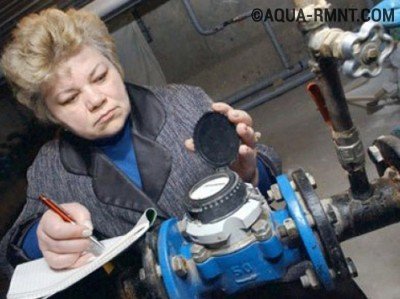
When calculating payments only in the months of the heating period, the formula is used:
P = S x N x Twhere
- S - total area of housing, m2;
- N is the normative norm of heat consumption, measured in gigacalories per square meter;
- T - 1 Gcal tariff established by the local administration, agreed with the service provider, rubles / Gcal.
If the heat energy charge is divided into all months of the year, then the conversion factor K = 0.58 should be added to the formula (as in the previous case, it is calculated by dividing 7 months of the heating season by 12 months). Thus, the formula will look like:
P = S x (N x K) x T
As in the previously noted case, the total amount of annual payments will be the same.
Lack of OPU when it can be installed
If the house does not have a common house meter, but it is technically possible to install it, then the following formula is used to charge during the heating season:
P = S × N × Kpov × Twhere
- S - area of the desired premises (in sq.m);
- N - heat consumption standard (Gcal / sq.m);
- Kpov - increasing coefficient, the value of which varies. In 2016, this figure was 1.4, and from January 1, 2017 it rose to 1.5;
- T is the tariff for thermal energy established in this region (rubles / Gcal).
In the case of a monthly payment of heat during the year, the resulting number is multiplied by the coefficient K = 0.58 already known to us (for the seven-month heating season).
Calculation of heat with an OPU and individual meters
A similar option is often found in newly rented houses. In this case, the calculation is made according to the formula:
P = (Vand + Vabout x S / Sabout ) x Twhere
Vand - the amount of heat consumed during the estimated period according to the indications of individual flow meters (Gcal);
Vabout - the amount of heat in gigacalories delivered to the residents of the house according to the total meter, with the exception of the amount consumed, which is determined by the formula:
Pi = (Vin + Viodk × Si/ Sabout) × Tt where
- Vn - the amounts of heat consumed during the calculated interval, determined according to the indications of common house devices for the duration of the heating season (Gcal);
- Si - the area of the living room equipped with an individual meter (sq.m);
- Vodk - the amount of electricity according to the indications of individual flow meters installed in apartments;
- Sabout - the total area of residential and office space in the house (square meters);
- Tt - The heat tariff adopted in the area.
In this case, payment is made exclusively during the heat supply season.
Benefits of Using Counters
Common house flow meters can significantly save on heating. The price for heat, calculated according to actual indicators, is on average 30% lower than by standards.
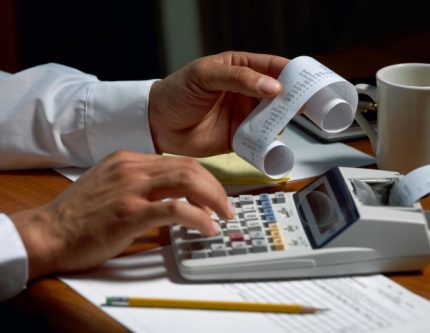
In addition, when paying at the established rates, the beginning / end of the heating period is not taken into account: regardless of the specific data, the calculation is made for the whole month.
But the common house meter does not solve all the problems with paying for heating, because in this case you have to pay according to the averaged data to all the apartment owners, regardless of the amount of heat consumed.
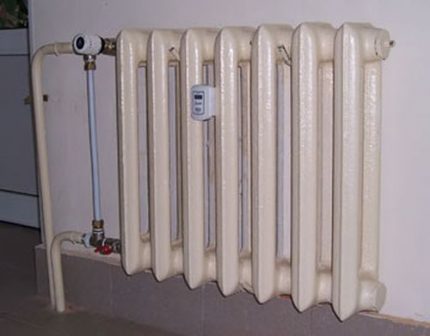
In this case, tenants will help out individual heat meter, which also allows you to adjust the heat transfer of radiators.
Calculation of heating standards
When developing the norms of heat consumption, it is taken into account:
- The total heat consumption, which is necessary for heating all rooms during the heating season.
- The total area of heated spaces in the building, as well as buildings connected to the heating system.
- Duration of the heating season (including incomplete calendar months in which measurements were taken).
- In addition, when carrying out calculations, the daily average temperatures of heated air indoors and cold outside are mandatory taken into account (measurements are taken during the heating season).
In the first case, the indicators indicated in the regulatory documents for the provision of public services to the population are taken as the basis. In the second, the average statistical value for the five previous heating periods is taken into account (data are provided by the regional hydrometeorological service).
An important parameter is also the average maximum temperature, which is calculated by measuring the five most frosty winter days following each other.
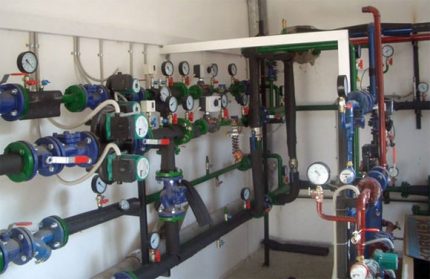
In the temperate zone, central heating services are usually provided for 7-8 months - from September-October to April-May; in the first and last months, fees may apply at a reduced rate of consumption.
Approval and Tariff Approval Process
All calculated indicators are compiled by specialists and employees of heat supply organizations. Then they are mandatory approved by the energy commissions operating within a particular locality, region, territory.
Representatives of local authorities and public organizations, as well as deputies of various levels, are also invited to a meeting where they consider the planned prices for heat.
Tariffs are calculated in accordance with legislative acts of the Government of the Russian Federation, which establish consumption standards for utilities, including the amount of heat energy. Heat supply organizations need to confirm and justify the proposed prices for heating services.
Since the actual outdoor temperature during the heating season may not coincide with the calculated standards, once a year utilities are recalculated.
In severe cold weather, consumers will have to pay a certain amount, while in mild winters an overpayment is possible, which is counted towards future payments. The same procedure is carried out once a year in homes where flow meters are not provided.
Conclusions and useful video on the topic
The video presented presents the opinion of a specialist regarding the benefits that are provided by common house heat meters.
A common house meter is a useful device that can significantly reduce very large heating costs. Despite the high cost, the funds for its installation quickly pay off, especially with the conscious interaction of residents taking joint measures to reduce heat consumption.
Please write comments in the block below. Tell us about your experience in using common house meters and in performing calculations based on readings taken from them. Share information that will be useful to visitors to the site, publish photos, ask questions.

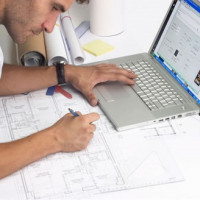 Calculation of the heating system of a private house: rules and examples of calculation
Calculation of the heating system of a private house: rules and examples of calculation  Calculation of air heating: basic principles + calculation example
Calculation of air heating: basic principles + calculation example 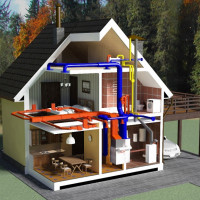 Cottage heating: schemes and nuances of organizing an autonomous heating system
Cottage heating: schemes and nuances of organizing an autonomous heating system 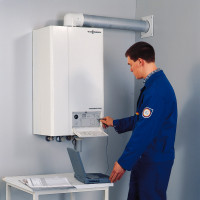 How to calculate the power of a gas heating boiler: formulas and calculation example
How to calculate the power of a gas heating boiler: formulas and calculation example 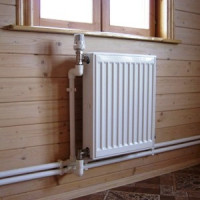 How to arrange the heating of a private house with your own hands: schemes for organizing an autonomous heating system
How to arrange the heating of a private house with your own hands: schemes for organizing an autonomous heating system 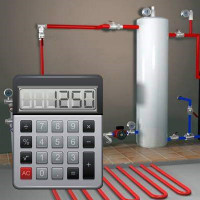 The average gas consumption for heating a house is 150 m²: an example of calculations and an overview of heat engineering formulas
The average gas consumption for heating a house is 150 m²: an example of calculations and an overview of heat engineering formulas  How much does it cost to connect gas to a private house: the price of organizing gas supply
How much does it cost to connect gas to a private house: the price of organizing gas supply  The best washing machines with dryer: model rating and customer tips
The best washing machines with dryer: model rating and customer tips  What is the color temperature of light and the nuances of choosing the temperature of the lamps to suit your needs
What is the color temperature of light and the nuances of choosing the temperature of the lamps to suit your needs  Replacement of a geyser in an apartment: replacement paperwork + basic norms and requirements
Replacement of a geyser in an apartment: replacement paperwork + basic norms and requirements
We began to “save” after a year we paid for the meter. I can’t understand why common house flow meters are so expensive? But still, it seems to me that there are flaws in this payment system, since the price of heating has not become much lower. A maximum of 300-500 rubles is saved. And yet, boiler houses, in order to get more benefits, are drowned in full, despite the daily temperature, which can reach +20 with us. Here at least save, at least do not save.
Hello. The comment is not quite clear. That is, before you paid according to the standard, but now you have installed profit and loss tax and still pay too much in your opinion? Regarding the temperature in the rooms, the maximum limit in the living room is +24 degrees, the minimum is 18 degrees, and in the corners, the minimum is 20, so here you have everything strictly according to SanPin and the boiler rooms are not beneficial.
And you have not installed IPU apartment by apartment? Wiring does not allow?
Initial expenses for the purchase and installation of equipment cost us a pretty penny. The inhabitants of our house have been raising money for almost two years, if it had not been for the head of the meeting of tenants, they would hardly have brought the matter to an end. In general, spending on heat decreased, but not by much.On the other hand, an unpleasant moment was revealed. There was a need for repair and maintenance of the meter, since the water in the city is bad. Over time, the depreciation will be more and, therefore, the cost of fixing it.